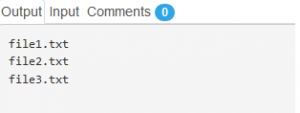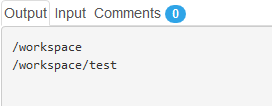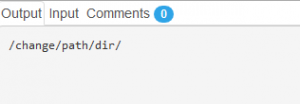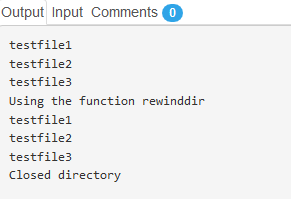Updated March 27, 2023
Introduction to PHP Directory
PHP directory functions as their name suggests are a set of functions used in retrieving details, modifying them and fetching information on various file system directories and their specific contents. A lot of operations can be performed on the directories like creating, deleting, changing the present working directory, listing files present in the directory and so on. There is no separate installation required for these functions as they come as part of the PHP core. But to enable chroot() function we need to configure –enable-chroot-func option.
Functions of PHP Directory
Let us go through a few of the basic PHP directory functions as below:
1. Create a New Directory
We use the mkdir() function to create a new directory in the PHP programming script.
Syntax:
mkdir($dir_path,$mode,$recursive_flag,$context);where,
- $dir_path is either the relative or the absolute path where the new directory specified will be created.
- $mode is the parameter that will take in octal values which determines the level in which the newly created directory will be accessible.
- $recursive is a flag type field that has 2 values either true or false which can either allow us to create nested directories or not.
- $context is similar to what we have with PHP unlink() like having a stream to specify certain protocols etc. This will also return only a boolean value which will be true if the execution is completed successfully and false otherwise.
Example:
<?php
mkdir("/articles/");
echo("Directory created");
?>Output:
This is a basic example to show the creation of a directory in the path we require. Make sure the path has sufficient permissions else “permission denied” error will be thrown.
2. List the Contents of a Directory
We use opendir() and readdir() for opening the directory link and to read it respectively. Step 1 will be to open the directory and Step 2 will be to read it.
Step 1: To open the directory link, opendir() is the function we use to do this step. It requires two input arguments as specified below.
Syntax:
opendir($dir_path,$context);- $dir_path is the path of the directory which needs to be opened.
- $context is an optional parameter where we can specify if a context stream is present.
This returns resource data value as its output. This resource ID which it provides is used in our further processing steps else we get an error as resource ID is invalid.
Step 2: To read the contents of the directory, readdir() is the function which is used for this purpose and it needs to be called recursively till the end of the directory is reached by the directory handle.
Example:
<?php
$direct = "/files/";
if (is_dir($direct)){
if ($td = opendir($direct)){
while (($file = readdir($td)) !== false){
echo "filename:" . $file . "<br>";
}
closedir($td);
}
}
?>Output:
In this example first, we are declaring the directory path which needs to be read. We are checking in the if statement if the directory is present and then proceeding to open the contents of the directory and read. The output displays the filenames present inside the directory.
3. To Close a Directory
We use closedir() function in order to close a directory after reading its contents.
Syntax:
$dir_handle = opendir($dir_path);
...
...
closedir($dir_handle);Example:
<?php
$dir = "/file1";
if (is_dir($dir)) {
if ($dh = opendir($dir)) {
$direc = readdir($dh);
echo("File present inside directory are:" .direc);
closedir($dh);
echo("Closed directory");
}
}
?>Output:
In this example, we are first declaring the path of our directory. Then using the if conditional statement we are checking if the path is valid and if yes, then we are opening the directory, reading its variables and then closing it. Thus, any operation can be done between the opening and closing of the directory.
4. To Change the Current Directory
We use the function chdir() to change the current working directory in which it is pointing to.
Syntax:
chdir(directory)It requires only one parameter that is the directory to which the current working directory should be pointed to. It returns true on success and false if failed to change the directory.
Example:
<?php
// Get current directory
echo getcwd()."\n";
// Change directory
chdir("/workspace/test");
// Get current directory
echo getcwd();
?>Output:
In this example, we are first printing the present working directory. Then we are changing the same using chdir function to “test” directory and printing the same on the output. Hence make sure the entire path we are giving here exists.
5. To Change the Directory Path of Root
We use the function chroot() for changing the root directory of the ongoing process to the directory path we pass as an argument in this function. Also, the present working directory path will be changed to “/”. To perform this function one needs root permission/privileges.
Syntax:
chroot(directory)Example:
<?php
// Changing root directory path
chroot("/change/path/dir/");
// Displaying present directory
echo getcwd();
?>Output:
In this example, we are first using the chroot function to change the path of the root directory. Next, we are displaying the present working directory which will be now changed to home path.
6. To Reset the Directory Handle
For this purpose, we are using rewinddir() function which can reset the directory handle initially created by opendir() function.
Syntax:
rewinddir(directory)It accepts only the directory path as its input argument which is used to tell the directory handle resource path which was opened with opendir() previously. This is an optional parameter which if not specified then the previous link used by the opendir() will be considered.
Example:
<?php
$direc = "/file/";
// To open the directory and read its contents
if (is_dir($direc)){
if ($place = opendir($direc)){
// List files in images directory
while (($file = readdir($place)) !== false){
echo "filename:" . $file . "\n";
}
rewinddir();
echo("Using the function rewinddir\n");
// List files again
while (($file = readdir($place)) !== false){
echo "filename:" . $file . "\n";
}
closedir($place);
echo("Closed directory");
}
}
?>Output:
In this example first, we are specifying the directory path and if statement we are using to verify if the directory path is present or not. If the directory is present then we are opening and reading the contents of the file and printing the same. Now the file handler will stop printing since it reached the end of file pointer. When we use the rewinddir() function it resets the file handler and hence when we print the directory contents it prints the same output again.
Conclusion
We have gone through some of the basic and important PHP directory functions commonly used in this article. We also noticed that a few of these functions are dependant on each other. For example, we cannot use readdir() without using opendir(). Few other functions which are used are dir(), scandir() and getcwd().
Recommended Articles
This is a guide to PHP Directory. Here we discuss the Introduction and we learned how to show all files in a directory of a website using PHP. You may also have a look at the following articles to learn more –









